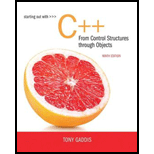
Starting Out with C++ from Control Structures to Objects Plus MyLab Programming with Pearson eText -- Access Card Package (9th Edition)
9th Edition
ISBN: 9780134544847
Author: Tony Gaddis
Publisher: PEARSON
expand_more
expand_more
format_list_bulleted
Expert Solution & Answer
Chapter 21, Problem 21RQE
Explanation of Solution
Binary tree:
A complete binary tree is a tree with the property that every node must have exactly two children, and at the last level, the nodes should be from left to right. But an incomplete binary tree has a node with zero or one or two children.
- First node must be the root of the tree.
- The second node must be the left child of the root
- The third node must always be the right child of the root.
- The next node must start to fill the next level from left to right.
- But, here it is important to note that not all the nodes in the binary tree have two children. Some may have single node or some may not have any nodes...
Expert Solution & Answer
Want to see the full answer?
Check out a sample textbook solution
Students have asked these similar questions
Capsim Team PowerPoint Presentations - Slide Title: Key LearningsWhat were the key learnings that you discovered as a team through your Capsim simulation?
Write the SQL code that permits to implement the tables: Student and Transcript. NB: Add the constraints on the attributes – keys and other.
Draw an ERD that will involve the entity types: Professor, Student, Department and Course. Be sure to add relationship types, key attributes, attributes and multiplicity on the ERD.
Chapter 21 Solutions
Starting Out with C++ from Control Structures to Objects Plus MyLab Programming with Pearson eText -- Access Card Package (9th Edition)
Ch. 21.1 - Prob. 21.1CPCh. 21.1 - Prob. 21.2CPCh. 21.1 - Prob. 21.3CPCh. 21.1 - Prob. 21.4CPCh. 21.1 - Prob. 21.5CPCh. 21.1 - Prob. 21.6CPCh. 21.2 - Prob. 21.7CPCh. 21.2 - Prob. 21.8CPCh. 21.2 - Prob. 21.9CPCh. 21.2 - Prob. 21.10CP
Ch. 21.2 - Prob. 21.11CPCh. 21.2 - Prob. 21.12CPCh. 21 - Prob. 1RQECh. 21 - Prob. 2RQECh. 21 - Prob. 3RQECh. 21 - Prob. 4RQECh. 21 - Prob. 5RQECh. 21 - Prob. 6RQECh. 21 - Prob. 7RQECh. 21 - Prob. 8RQECh. 21 - Prob. 9RQECh. 21 - Prob. 10RQECh. 21 - Prob. 11RQECh. 21 - Prob. 12RQECh. 21 - Prob. 13RQECh. 21 - Prob. 14RQECh. 21 - Prob. 15RQECh. 21 - Prob. 16RQECh. 21 - Prob. 17RQECh. 21 - Prob. 18RQECh. 21 - Prob. 19RQECh. 21 - Prob. 20RQECh. 21 - Prob. 21RQECh. 21 - Prob. 22RQECh. 21 - Prob. 23RQECh. 21 - Prob. 24RQECh. 21 - Prob. 25RQECh. 21 - Prob. 1PCCh. 21 - Prob. 2PCCh. 21 - Prob. 3PCCh. 21 - Prob. 4PCCh. 21 - Prob. 5PCCh. 21 - Prob. 6PCCh. 21 - Prob. 7PCCh. 21 - Prob. 8PC
Knowledge Booster
Similar questions
- Draw an ERD that represents a book in a library system. Be sure to add relationship types, key attributes, attributes and multiplicity on the ERD.arrow_forward2:21 m Ο 21% AlmaNet WE ARE HIRING Experienced Freshers Salesforce Platform Developer APPLY NOW SEND YOUR CV: Email: hr.almanet@gmail.com Contact: +91 6264643660 Visit: www.almanet.in Locations: India, USA, UK, Vietnam (Remote & Hybrid Options Available)arrow_forwardProvide a detailed explanation of the architecture on the diagramarrow_forward
- hello please explain the architecture in the diagram below. thanks youarrow_forwardComplete the JavaScript function addPixels () to calculate the sum of pixelAmount and the given element's cssProperty value, and return the new "px" value. Ex: If helloElem's width is 150px, then calling addPixels (hello Elem, "width", 50) should return 150px + 50px = "200px". SHOW EXPECTED HTML JavaScript 1 function addPixels (element, cssProperty, pixelAmount) { 2 3 /* Your solution goes here *1 4 } 5 6 const helloElem = document.querySelector("# helloMessage"); 7 const newVal = addPixels (helloElem, "width", 50); 8 helloElem.style.setProperty("width", newVal); [arrow_forwardSolve in MATLABarrow_forward
- Hello please look at the attached picture. I need an detailed explanation of the architecturearrow_forwardInformation Security Risk and Vulnerability Assessment 1- Which TCP/IP protocol is used to convert the IP address to the Mac address? Explain 2-What popular switch feature allows you to create communication boundaries between systems connected to the switch3- what types of vulnerability directly related to the programmer of the software?4- Who ensures the entity implements appropriate security controls to protect an asset? Please do not use AI and add refrencearrow_forwardFind the voltage V0 across the 4K resistor using the mesh method or nodal analysis. Note: I have already simulated it and the value it should give is -1.714Varrow_forward
arrow_back_ios
SEE MORE QUESTIONS
arrow_forward_ios
Recommended textbooks for you
 C++ Programming: From Problem Analysis to Program...Computer ScienceISBN:9781337102087Author:D. S. MalikPublisher:Cengage Learning
C++ Programming: From Problem Analysis to Program...Computer ScienceISBN:9781337102087Author:D. S. MalikPublisher:Cengage Learning Systems ArchitectureComputer ScienceISBN:9781305080195Author:Stephen D. BurdPublisher:Cengage Learning
Systems ArchitectureComputer ScienceISBN:9781305080195Author:Stephen D. BurdPublisher:Cengage Learning New Perspectives on HTML5, CSS3, and JavaScriptComputer ScienceISBN:9781305503922Author:Patrick M. CareyPublisher:Cengage Learning
New Perspectives on HTML5, CSS3, and JavaScriptComputer ScienceISBN:9781305503922Author:Patrick M. CareyPublisher:Cengage Learning- Programming Logic & Design ComprehensiveComputer ScienceISBN:9781337669405Author:FARRELLPublisher:Cengage
 EBK JAVA PROGRAMMINGComputer ScienceISBN:9781337671385Author:FARRELLPublisher:CENGAGE LEARNING - CONSIGNMENT
EBK JAVA PROGRAMMINGComputer ScienceISBN:9781337671385Author:FARRELLPublisher:CENGAGE LEARNING - CONSIGNMENT C++ for Engineers and ScientistsComputer ScienceISBN:9781133187844Author:Bronson, Gary J.Publisher:Course Technology Ptr
C++ for Engineers and ScientistsComputer ScienceISBN:9781133187844Author:Bronson, Gary J.Publisher:Course Technology Ptr

C++ Programming: From Problem Analysis to Program...
Computer Science
ISBN:9781337102087
Author:D. S. Malik
Publisher:Cengage Learning

Systems Architecture
Computer Science
ISBN:9781305080195
Author:Stephen D. Burd
Publisher:Cengage Learning

New Perspectives on HTML5, CSS3, and JavaScript
Computer Science
ISBN:9781305503922
Author:Patrick M. Carey
Publisher:Cengage Learning

Programming Logic & Design Comprehensive
Computer Science
ISBN:9781337669405
Author:FARRELL
Publisher:Cengage

EBK JAVA PROGRAMMING
Computer Science
ISBN:9781337671385
Author:FARRELL
Publisher:CENGAGE LEARNING - CONSIGNMENT

C++ for Engineers and Scientists
Computer Science
ISBN:9781133187844
Author:Bronson, Gary J.
Publisher:Course Technology Ptr